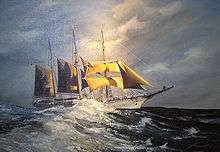Mercator (ship)
 The Mercator visiting Trinidad, c. 1960. | |
| History | |
|---|---|
| Name: | Mercator |
| Namesake: | Gerardus Mercator |
| Builder: | Ramage and Ferguson Ltd, Leith, Scotland |
| Launched: | 1932 |
| Fate: | Museum ship |
| General characteristics | |
| Tonnage: | 770 gross tons |
| Length: | 78.5 m (258 ft) overall; 68 m (223 ft) hull length[1] |
| Beam: | 10.6 m (35 ft) |
| Height: | foremast 39 m (128 ft); mainmast 41 m (135 ft); mizzenmast 40 metres (130 ft) |
| Draft: | 5.1 m (17 ft) |
| Sail plan: | Three-masted barquentine, 15 sails: four jibs, four square foresails, three staysails, two spankers, two gaff topsails |
| Speed: | 13 knots (24 km/h; 15 mph) |
| Crew: | 150 |
The barquentine Mercator was designed by the Antarctic explorer Adrien de Gerlache (1866–1934) as a training ship for the Belgian merchant fleet. She was named after Gerardus Mercator (1512–1594), Flemish cartographer. She was built in Leith, Scotland[2] and launched in 1932.
Besides being a training a ship, she was also used, mainly before World War II, for scientific observations, or as ambassador for Belgium on world fairs and in sailing events. This ship went through an incredible history.
In 1961, she became a floating museum, first in Antwerp, and finally from 1964 in the marina of Ostend, just in front of the city hall. Now in 2013, she remained there in the heart of the city where people can go in the ship.
 Mercator at sea, painting by Yasmina (Ostend, Belgium)  Mercator in the North Sea, painting by Freddy Van Daele (Hosdent, Belgium) |
Specifications
The Mercator is a composite rigging. The foremast carries square sails, the main mast and the mizzen mast are rigged with fore and aft-sails. Usually the Mercator carried 15 sails with a total surface of about 1600 m². By fair wind she could easily make 13 knots.
History
Mercator's real career started off in 1934 when the ship sailed from Pitcairn Island, Tahiti, Papeete, to the Marquis Islands and Honolulu for a Belgo-French scientific expedition. This was her seventh cruise and known to be a fairly remarkable one to those preceding World War Two.
In 1936 Ostend's Mercator had the great honor to bring over Flemish missionary and apostle of the lepers, Pater Damiaan's mortal remains from Molokai island.
On February 21, 1940, Mercator was off for its last cruise before World War 2. It sailed to Rio de Janeiro and afterward arrived in Boma.
From early 1945 to mid 1947, the ship was taken under custody of the British Admiralty as a "Submarine Depot Ship". Unfortunately after 1947 the elegant ship that it once was, wouldn't be able to be put to sea again until January 20, 1951. After the horrible experience in Great Britain it went back to Belgium to work greatly on its maintenance.
Until the year of 1960, Mercator came back into service as a training ship and completed 41 voyages where it sailed almost all seas. After that it completed quite a few scientific missions. Besides that it completed even races in Torbay-Lisbon (1956), Brest-Canary Islands (1958) and Oslo-Ostend (1960).
All these Historic events of the ship couldn't be done without the captains: Captain R. Van de Sande (from 1932 till 1955), Captain R. Ghys (from 1955 till 1960).
Books
- Gust Vandegoor: Commandant en schoolschip: Remi Van de Sande en de Mercator, 2009
- Werner Van de Walle: Mercator en de Belgische schoolschepen, 2012
References
- ↑ Schauffelen, Otmar (2005). Chapman Great Sailing Ships of the World. Hearst Books. p. 23. ISBN 978-1-58816-384-4. Retrieved 2009-02-10.
- ↑
External links
| Wikimedia Commons has media related to: |
- Museum site for barquentine Mercator - Ostend, Belgium
- Imperial War Museum Collection Search HMS Mercator (search results). Accessed 30 June 2012
- "Mercator." Mercator. N.p., n.d. Web. 21 Feb. 2013.
Coordinates: 51°13′38″N 2°55′14″E / 51.22722°N 2.92056°E